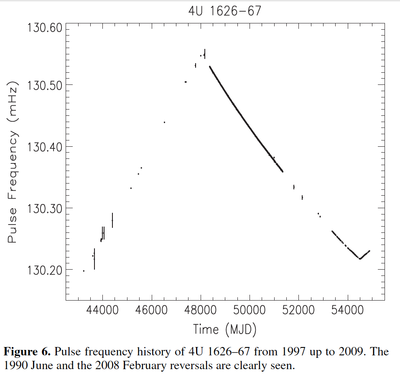4U 1626-67
Other names : 3U 1626-67 (Simbad)
Monitoring data: CGRO/BATSE, RXTE/ASM, Swift/BAT, MAXI, Fermi/GBM pulsed flux,Fermi/GMB Occultation Project
Coordinates
| RA | 16h 32' 16.8" | Dec | -67° 27' 43" |
| RA | 248.0699 | Dec | -67.4617 |
Binary system
Distance
The distance is estimated to be between 5 and 13 kpc ([1]).
Orbit
| Parameter | Value | Unit | Reference |
|---|---|---|---|
| Porb | 42 | min | [1] |
| i | 18 | deg | [2] |
Note : Porb was obtained from the optical lightcurve, due to reprocessed emission, it has not yet been detected from the neutron star pulsed X-ray emission ([3] and therein).
Optical Companion
Names :' V* KZ TrA ([4])
| Parameter | Value | Unit | Reference |
|---|---|---|---|
| Mass | 0.04 | M⊙ | [2] |
| V | ~ 17.5 | [4] |
Available data
- ASCA: one observation in 1993 of ~75 ksec
- RXTE: many monitorings between 1996 and 2010, ranging from 1.2-73.6 ksec in exposure time
- Chandra: three observations (2000, 2003, 2010) > 30 ksec
- XMM Newton: four observations
- BeppoSAX: one observation in 1996
- INTEGRAL: many observations since 2003
- Swift: twelve observations in 2005 and one in 2008
- Suzaku: two observations in 2007 of 100 ksec and in 2011 of 20 ksec, respectively
Description
Discovered in 1972 by Uhuru ([5]). 4U 1626-67 is a LMXB, with a very compact system composed of a faint blue star and an accreting X-ray pulsar with an almost completely face-on orbit ([4], [2]). The accretion occurs through Roche-lobe overflow ([6]). The neutron star has a magnetic field in the range 2.4-6.3 x 1012 G ([7]). The source has shown stable spin-up or spin-down with two torque reversals in 1991 ([8]) and 2008 ([9]).
Flux
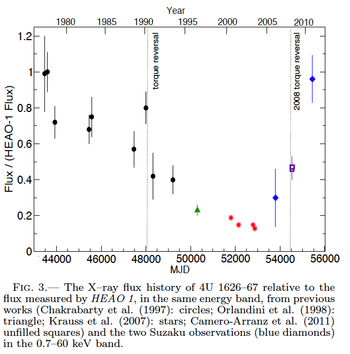 Figure above obtained from [10].
Figure above obtained from [10].
The source has shown gradually decreasing flux and luminosity (~2.5 x 1034 d2kpc - 10 x 1034 d2kpc ([10]) until the torque reversal in 2008, when the intensity started increasing.
A QPO frequency of 40 mHz, was found from Ginga observations ([11]). Later with BeppoSAX ([12]), ASCA ([13]), RXTE ([14]), and XMM-Newton ([15]) a QPO frequancy of 48 mHz was determined.
[16] found that the QPO frequency trend in 4U 1626-67 went from positive to a negative. During the spin-up period, the QPO central frequency increased from ~36 mHz in 1983 to ~49 mHz in 1993. In the spin-down period, it gradually decreased at a rate ~(0.2 ± 0.05) mHz yr-1. After the last torque reversal, no QPO was observed ([3]).
Spectrum
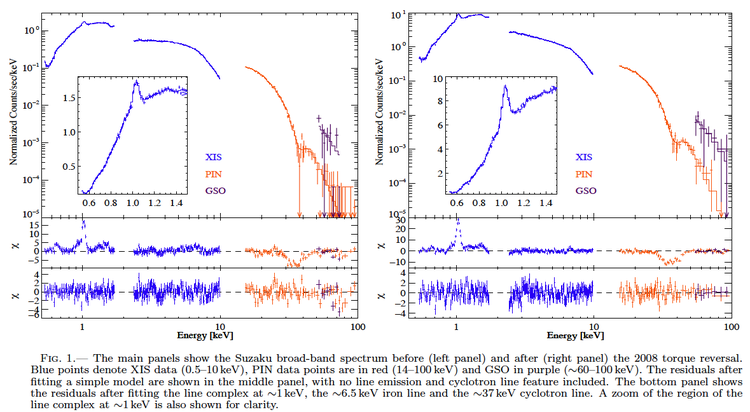 Figure above obtained from [10].
Figure above obtained from [10].
The spectrum consists of a low-energy absorption, a blackbody and a high-energy cutoff power law.
The spectrum also shows a cyclotron line feature at ~37 keV an iron K fluorescence line at ~6.4 keV and additional emission lines between 0.5 and 1.5 keV ([10]).
Pulse Profile
A 7.7s X-ray pulsar, 4U 1626-67 has a complex, energy- and time-dependent pulse profile ([17]).
Figure below obtained from [17].
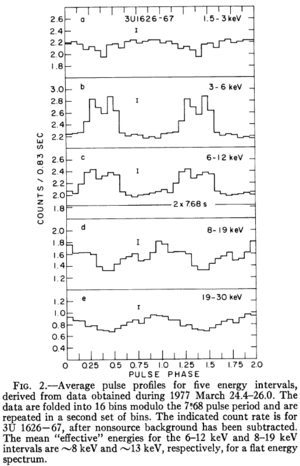
Figure below obtained from [3].
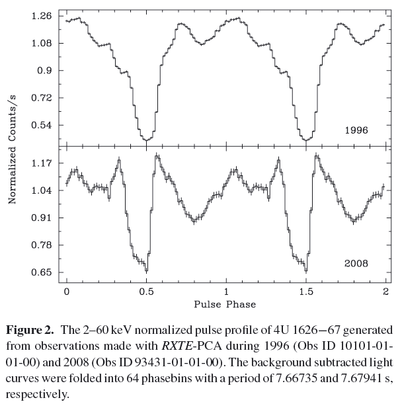
Pulse Period Evolution
The source showed an abrupt torque reversal in mid-1990 ([8]).
Observed with Swift/BAT, a second large torque reversal occurred on Feb 2008, with a transition lasting ~150 days ([9]).
Figure below obtained from [9].
References
- ↑ 1.0 1.1 Cite error: Invalid
<ref>tag; no text was provided for refs namedChakrabarty98 - ↑ 2.0 2.1 2.2 Cite error: Invalid
<ref>tag; no text was provided for refs namedLevine88 - ↑ 3.0 3.1 3.2 Cite error: Invalid
<ref>tag; no text was provided for refs namedJain10 - ↑ 4.0 4.1 4.2 Cite error: Invalid
<ref>tag; no text was provided for refs namedMcClintock77 - ↑ Cite error: Invalid
<ref>tag; no text was provided for refs namedGiacconi72 - ↑ Cite error: Invalid
<ref>tag; no text was provided for refs namedReynolds97 - ↑ Cite error: Invalid
<ref>tag; no text was provided for refs namedOrlandini98b - ↑ 8.0 8.1 Cite error: Invalid
<ref>tag; no text was provided for refs namedBildsten93 - ↑ 9.0 9.1 9.2 Cite error: Invalid
<ref>tag; no text was provided for refs namedCamero10 - ↑ 10.0 10.1 10.2 10.3 Cite error: Invalid
<ref>tag; no text was provided for refs namedCamero12 - ↑ Cite error: Invalid
<ref>tag; no text was provided for refs namedShinoda90 - ↑ Cite error: Invalid
<ref>tag; no text was provided for refs namedOwens97 - ↑ Cite error: Invalid
<ref>tag; no text was provided for refs namedAngelini95 - ↑ Cite error: Invalid
<ref>tag; no text was provided for refs namedKommers98 - ↑ Cite error: Invalid
<ref>tag; no text was provided for refs namedKrauss07 - ↑ Cite error: Invalid
<ref>tag; no text was provided for refs namedKaur08 - ↑ 17.0 17.1 Cite error: Invalid
<ref>tag; no text was provided for refs namedRappaport77
